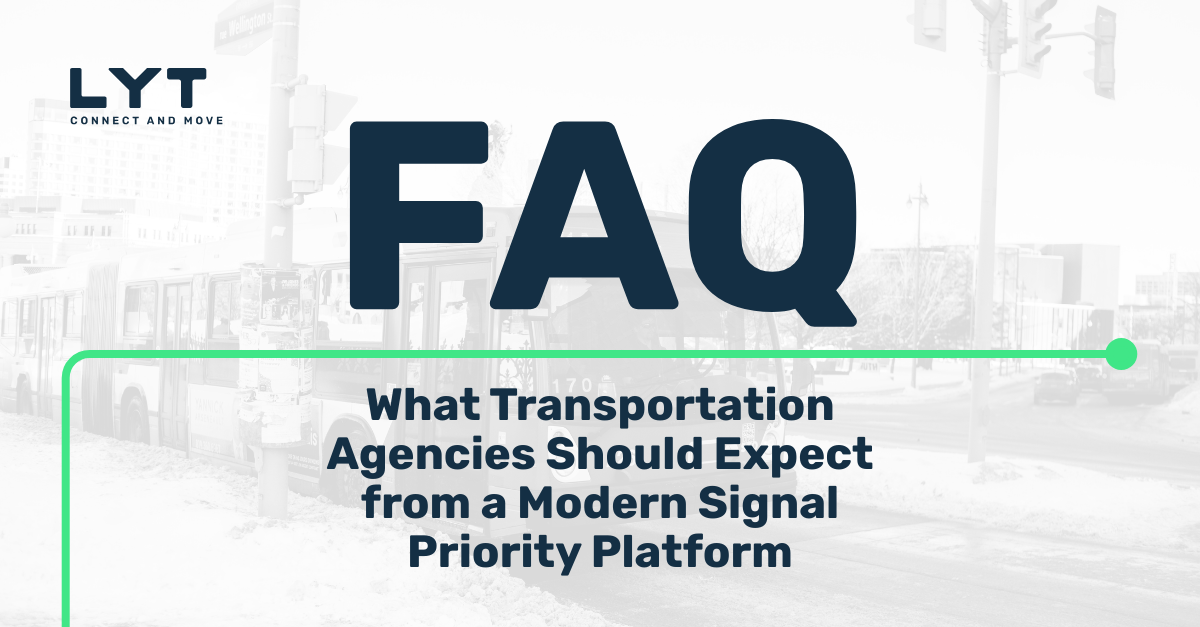City traffic teams are being asked to do more with less: move people efficiently, reduce emergency response times, support climate goals, and coordinate across departments. Signal priority platforms can help, but many agencies are still working with outdated or fragmented tools.
Whether you’re focused on transit signal priority (TSP), emergency vehicle preemption (EVP), or broader corridor visibility, it’s worth asking: what should a modern platform really deliver?
1. What is Transit Signal Priority (TSP), and how does it work?
Transit Signal Priority (TSP) allows buses and other service vehicles to request extended or early green lights at intersections. This helps reduce delays and improve schedule reliability. TSP systems typically use GPS or AVL feeds to detect vehicles and send requests to traffic signal controllers, optimizing signal timing in real time.
2. What is Emergency Vehicle Preemption (EVP), and how is it different from TSP?
Emergency Vehicle Preemption (EVP) gives priority to fire, police, or EMS vehicles so they can navigate intersections safely and quickly. While TSP focuses on service efficiency, EVP is centered on safety and response time. Modern platforms can support both, using flexible logic and vehicle-specific rules within the same system.
3. What should a signal priority platform offer today?
Legacy systems focus on triggering signal changes, but that’s no longer enough. A modern signal priority platform should provide:
- Real-time visibility into requests and signal response
- Support for multiple vehicle types and agencies
- Integration with AVL, CAD, and signal controller infrastructure
- Clear, role-based access for operators, planners, and leadership
- Scalable architecture that doesn’t require new vehicle hardware or RSUs
- Flexible enough to scale citywide as new corridors or problem areas are identified
4. Can TSP and EVP run on the same system?
Yes. With a connected vehicle platform like LYT, agencies can manage both TSP and EVP using a single interface. Rules can be set by vehicle type and context—keeping things simple for operators while maintaining control and safety.
5. What kind of data should your platform provide?
A signal priority platform should provide more than just counts. You should expect:
- Time-stamped records of each event
- Visualizations of route and corridor activity
- Real-time maps with signal status and vehicle movement
- Exportable reports to support operations, planning, and funding
- Tools to verify system health and identify issues quickly
6. Why does UI and UX matter in signal priority systems?
If your team can’t use the system easily, it doesn’t matter how powerful it is. A good UI reduces training time, improves adoption, and lowers the chance of missed information. Systems should work for planners, public safety, and field techs—without requiring a specialist to interpret the data.
7. How does LYT support these needs?
LYT’s New Experience includes:
- Unified view of live activity and analytics
- Interactive map with hover cards and real-time insights
- No need for additional vehicle hardware or RSUs
- Platform designed for transit, emergency response, and city fleets
- Scalable tools to grow from pilot to full deployment
- Easier identification of operational issues with improved data layout and real-time visualizations
8. Want to see it in action?
Book a demo to see how it can support your city’s mobility goals.
[Book a Demo]



